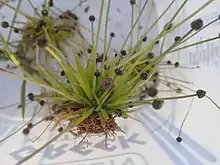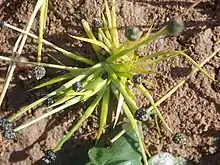Eriocaulon australasicum
Eriocaulon australasicum (common names southern pipewort, austral pipewort) is an endangered monocotyledonous plant in the Eriocaulaceae family found in Australia, in Victoria, South Australia and New South Wales.[2][6]
| Eriocaulon australasicum | |
|---|---|
 | |
 | |
| Scientific classification | |
| Kingdom: | Plantae |
| Clade: | Tracheophytes |
| Clade: | Angiosperms |
| Clade: | Monocots |
| Clade: | Commelinids |
| Order: | Poales |
| Family: | Eriocaulaceae |
| Genus: | Eriocaulon |
| Species: | E. australasicum |
| Binomial name | |
| Eriocaulon australasicum | |
| Synonyms[5] | |
|
Electrosperma australasicum F.Muell. | |
Description
Eriocaulon australasicum is a small, annual, semi-aquatic herb with a tuft of basal linear leaves which are 20–50 mm long by 1–1.5 mm wide. The flowers occur as egg-shaped to almost globular heads 3–4 mm wide. These are enclosed in lance-shaped outer bracts and by linear inner bracts. The fruits are smooth, with three celled capsules, which each contain a single seed. It possibly requires an inundation period to enable germination from soil-stored seed. Plants start to grow in shallow water (up to 20 cm deep), particularly when the water is clear and the substrate has high organic content. Flowering and seed-set swiftly follow falling water levels and the drying-out of depressions. Little is known about seed set, seed bank accumulation and its persistence and viability. It does not appear to reproduce vegetatively.[7]
Habitat
It grows in shallow, seasonally-inundated, depressions and on the margins of swamps on clay plains.[7]
Taxonomy
It was first described as Electrosperma australasicum by Ferdinand von Mueller in 1854, who found it "on wet places along the Murray, towards the junction of the Murrumbidgee".[3][8] It was transferred to the genus, Eriocaulon, in 1854 by Friedrich August Körnicke.[3][4]
Threats and recovery plan
Threats to the species are climate change, since Eriocaulon australasicum occurs in seasonally wet habitats, and probably requires a period of inundation to enable stored seed to germinate. With climate change, less frequent inundation of the required habitats will reduce habitat availability. A further threat is the grazing and trampling by sheep of the population in South Australia and possibly grazing by rabbits in Victoria.[7]
Current conservation actions in Victoria include the repair of boundary fencing to remove the grazing of the Little Desert population in Victoria, and the realignment of a vehicle track to eliminate the threat of vehicle disturbance. Additionally, fuel reduction programs in Victorian parks and reserves have been modified to avoid disturbance at sites where Eriocaulon australasicum occurs.[7]
References
- Williams, E. (2016). "Eriocaulon australasicum. The IUCN Red List of Threatened Species 2016: e.T22486370A22486834". doi:10.2305/IUCN.UK.2016-1.RLTS.T22486370A22486834.en. Retrieved 29 June 2020.
{{cite journal}}: Cite journal requires|journal=(help) - Department of the Environment (2020). "Species Profile and Threats database: Eriocalon australasicum". Canberra. Retrieved 29 June 2020.
- "Eriocaulon australasicum". Australian Plant Name Index, IBIS database. Centre for Plant Biodiversity Research, Australian Government.
- Körnicke, F.A. (1854). "Eriocaulacearum monographiae supplementum". Linnaea: Ein Journal für die Botanik in ihrem ganzen Umfange, oder Beiträge zur Pflanzenkunde. 27: 616.
- "Eriocaulon australasicum (F.Muell.) Körn. | Plants of the World Online | Kew Science". Plants of the World Online. Retrieved 29 June 2020.
- Leach, G.J. (2020). "Eriocaulon australasicum". In Kodela, P.G. (ed.). Flora of Australia. Australian Biological Resources Study, Department of Agriculture, Water and the Environment: Canberra. Retrieved 29 June 2020.
- Sutter, G. (2010). "National Recovery Plan for the Austral Pipewort Eriocaulon australasicum" (PDF). Department of Sustainability and Environment, Victoria.
- Mueller, F.J.H. von (18 September 1854). "Definitions of rare or hitherto undescribed Australian plants, chiefly collected within the boundaries of the colony of Victoria". Transactions of the Philosophical Society of Victoria. 1: 24.

